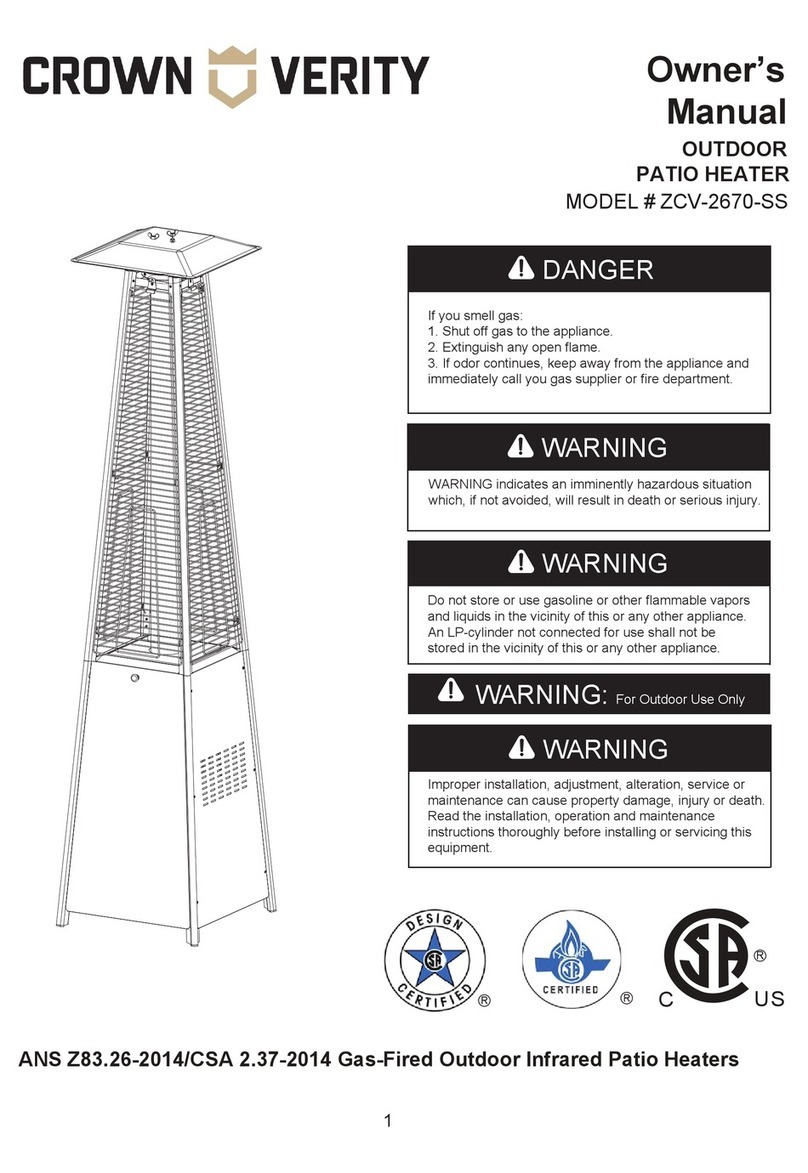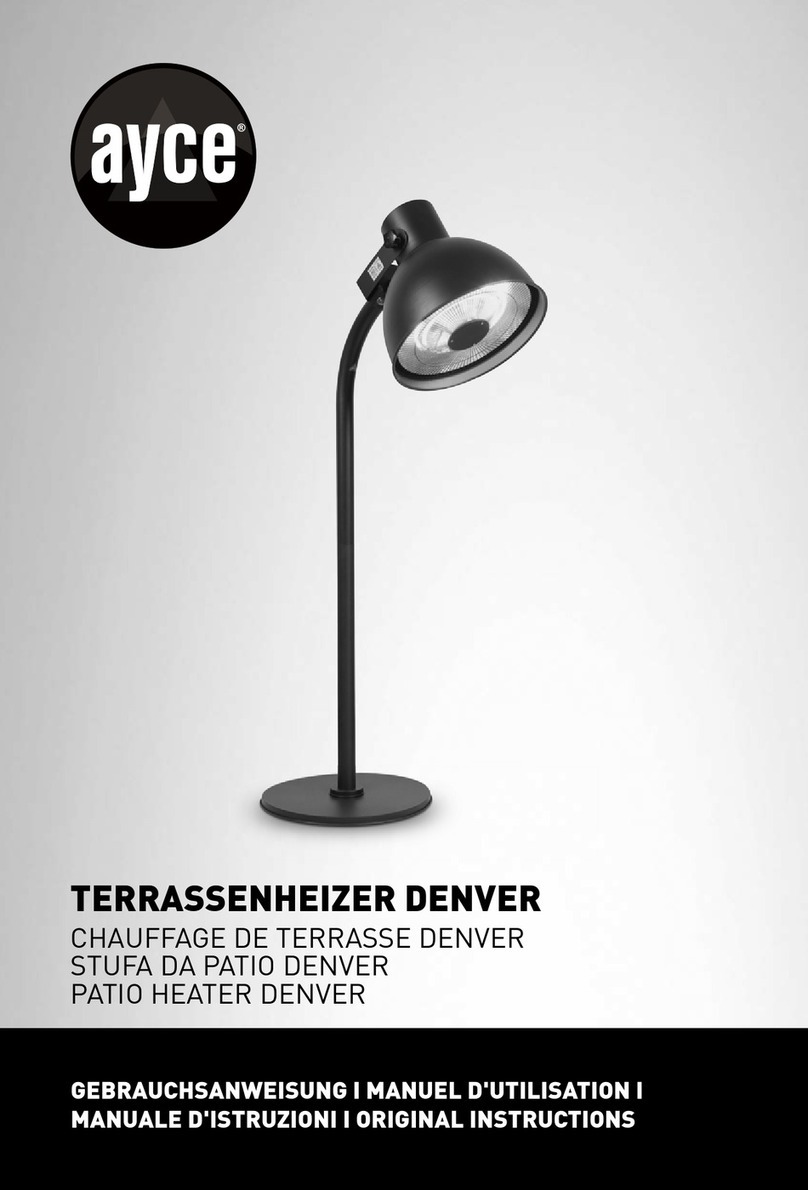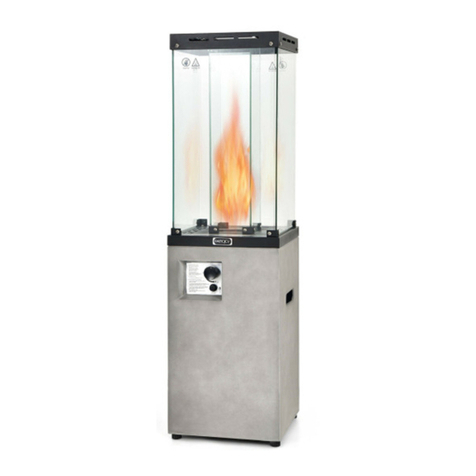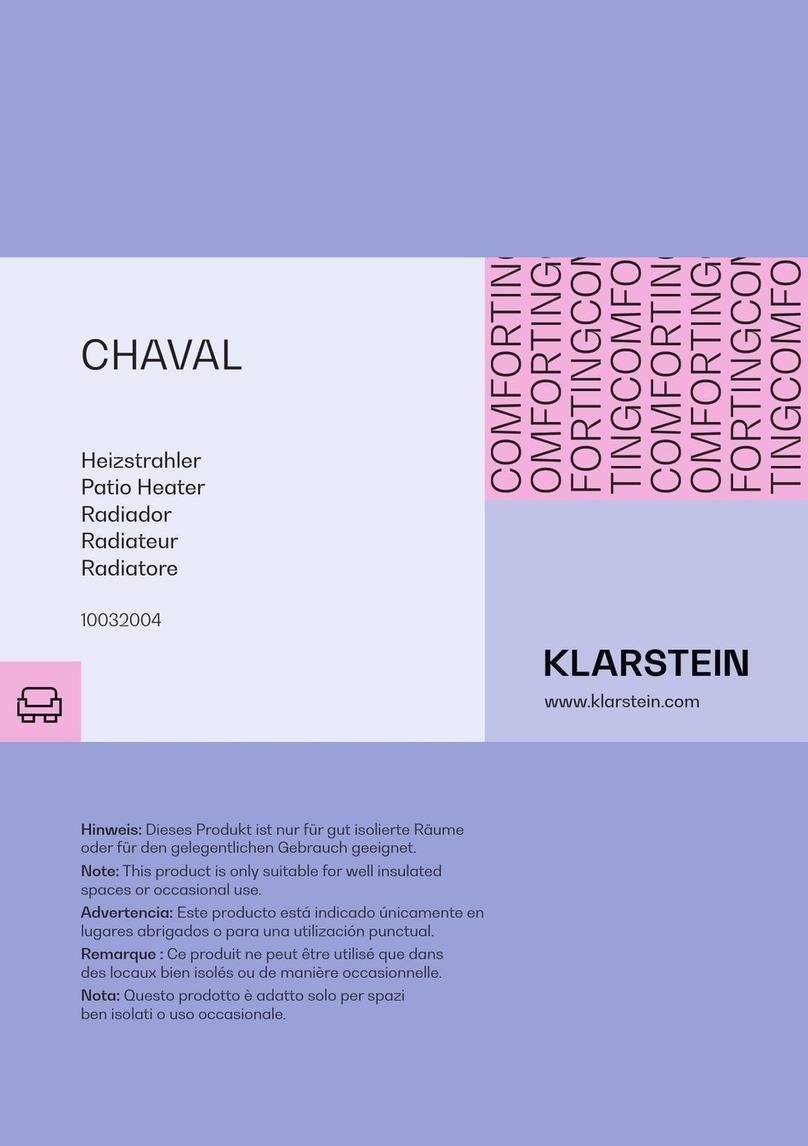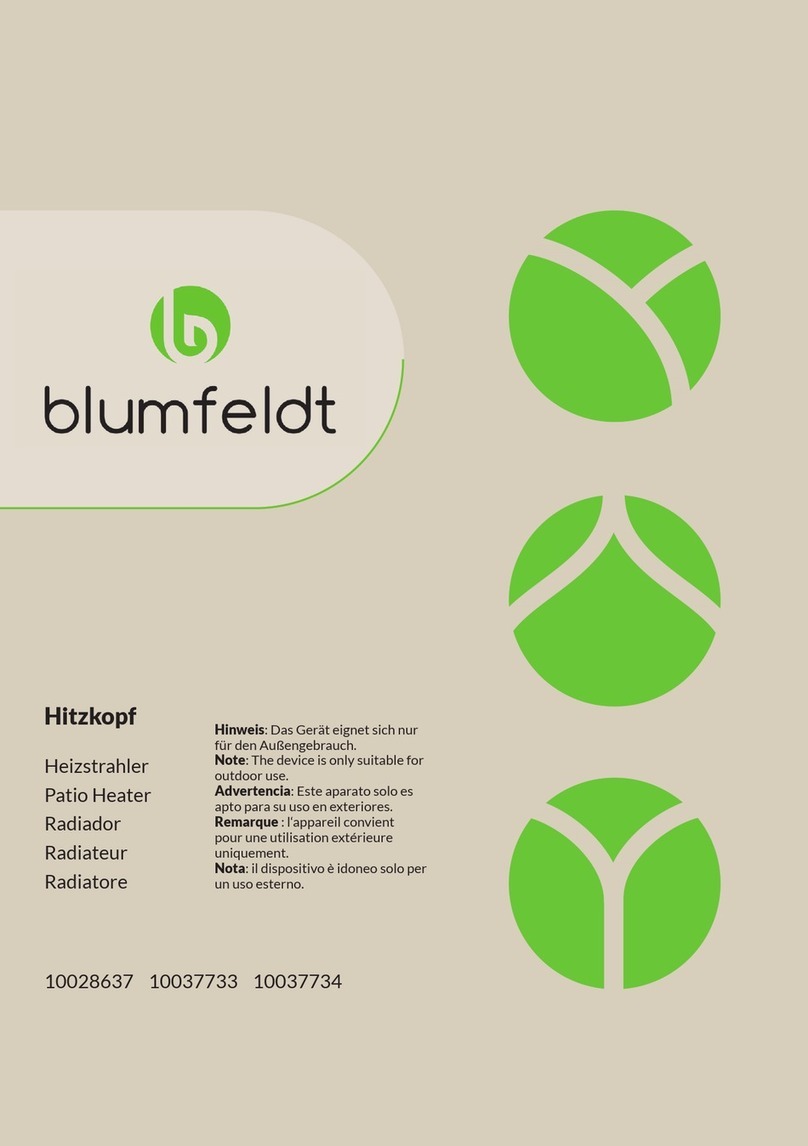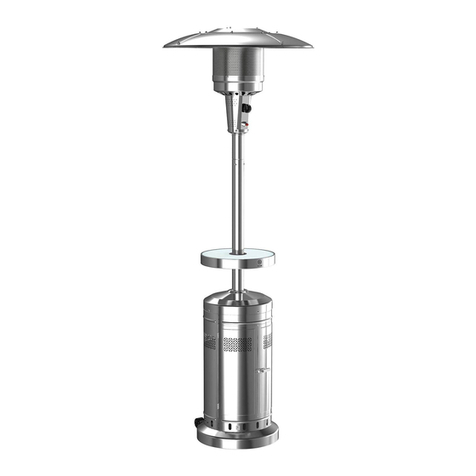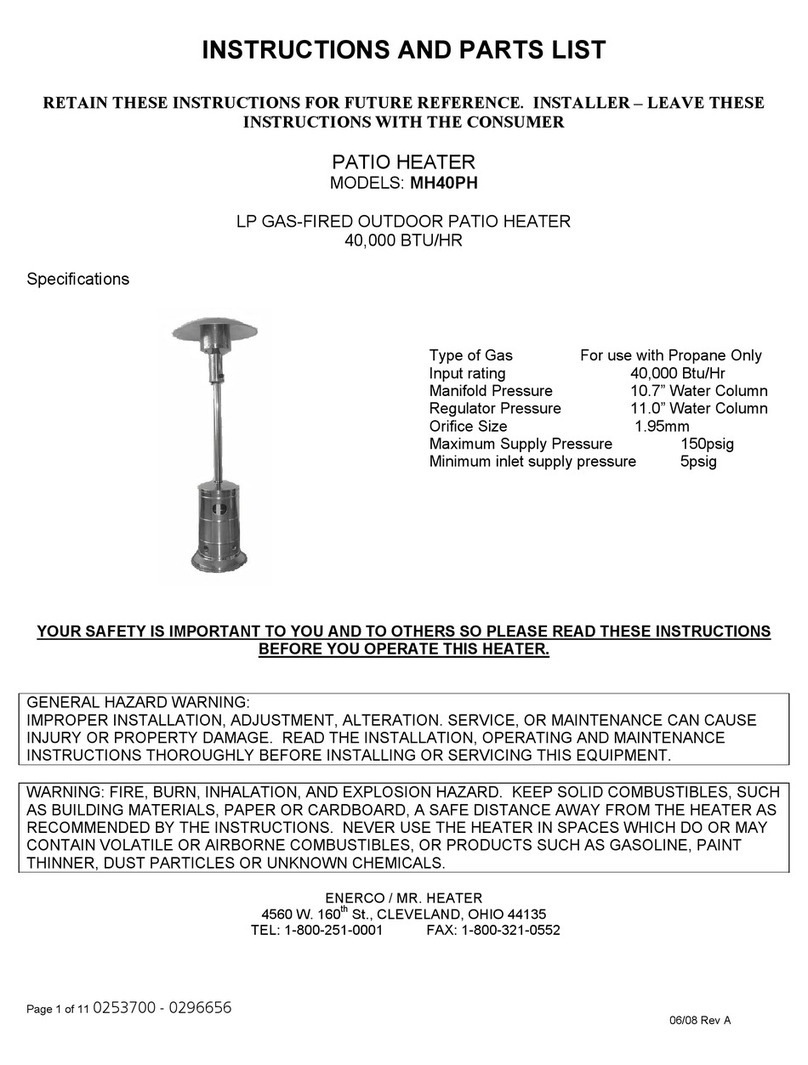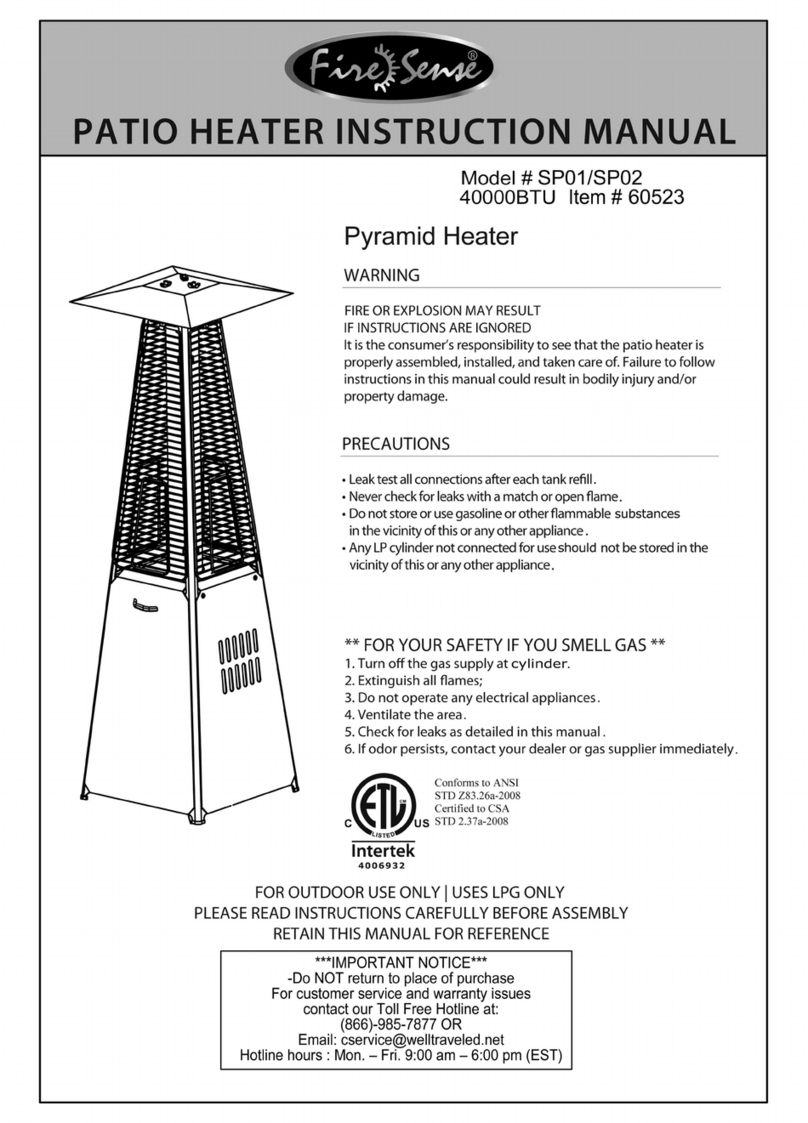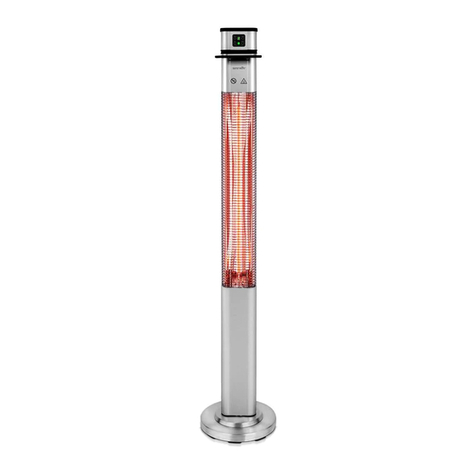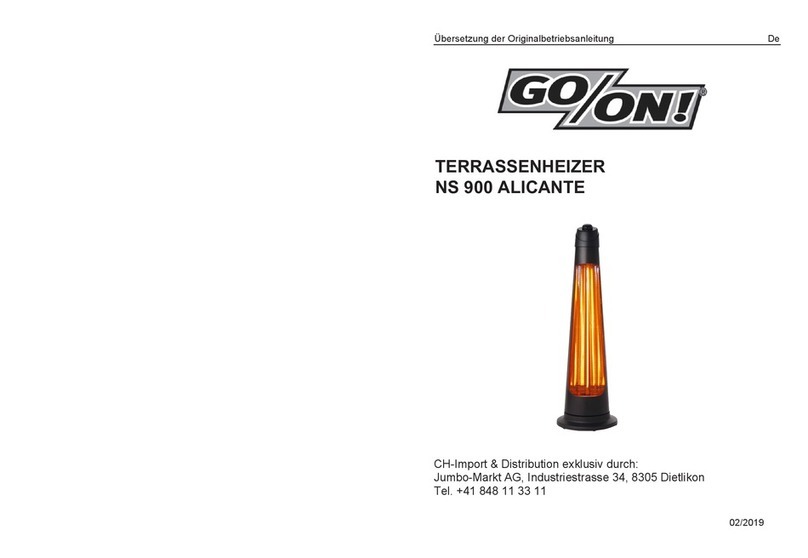CROWN VERITY ZCV-2650-SS User manual

ZCV-2650-SS
ZCV-2650-AB
ZCV-2650-SV

PACKAGE CONTENTS
2
NOITPIRCSEDTRAP QUANTITY
A
Reflector Panel
1
B 1
1
C
Head Assembly
D
Post
E
Regulator
F
G
H
I
J
Base
Bucket (preassembled)
1
1
1
1
1
2
1
Wheel Kit
Gas Hose
Cylinder Housing
Door (preassembled)
F
G
A
B
C
D
E
H
I
J

HARDWARE CONTENTS (shown actual size)
3
AA
JJ
DD EE HH
CC
LL MM NN
FF
BB GG
Φ8 Washer
Qty. 11
M5 x 8 mm
Screw
Qty. 4
M6 x 10 mm
Bolt
Qty. 4
M6 x 12 mm
Bolt
Qty. 8
Φ6
Small Flat
Washer
Qty. 4
Reinforced
Ring
Qty. 1
Wrench
Qty. 1
KK
Wing Nut
Qty. 3
Stainless
Steel Bolt
Qty. 4
SAFETY INFORMATION
Please read and understand this entire manual before attempting to assemble, operate or install
the product.
This manual contains important information about the assembly, operation and maintenance of
this patio heater. General safety information is presented in these first few pages and is also
located throughout the manual. Keep this manual for future reference and to educate new users
of this product. This manual should be read in conjunction with the labeling on the product. Safety
precautions are essential when any mechanical or propane-fueled equipment is involved. These
precautions are necessary when using, storing, and servicing this item. Using this equipment with the
respect and caution demanded will reduce the possibilities of personal injury or property damage.
The following symbols shown below are used extensively throughout this manual. Always heed
these precautions, as they are essential when using any mechanical or fueled equipment.
(not actual size)
(not actual size)
Deco Ring
Qty. 1
(not actual size)
DANGER
FOR YOUR SAFETY
If you smell gas:
1. Shut off gas to the appliance.
2. Extinguish any open flame.
3. If odor continues, keep away from the
appliance and immediately call your gas
supplier or fire department.
DANGER
Failure to comply with the precautions and
instructions provided with this heater can
result in death, serious bodily injury and
property loss or damage from hazards of fire,
explosion, burn, asphyxiation, and/or carbon
monoxide poisoning. Only persons who can
understand and follow the instructions
should use or service this heater.
M6 Nut
Qty. 8
M8 x 45mm Bolt
Qty. 2
M8 Nut
Qty. 2
II
Reflector
spacer
Qty. 3

SAFETY INFORMATION
4
DANGER
• CARBON MONOXIDE HAZARD
• This heater is a combustion appliance. All
combustion appliances produce carbon
monoxide (CO) during the combustion
process. This product is designed to
produce extremely minute, non-hazardous
amounts of CO if used and maintained in
accordance with all warnings and
instructions. Do not block air flow into or
out of the heater.
• Carbon Monoxide (CO) poisoning
produces flu-like symptoms, watery eyes,
headaches, dizziness, fatigue and possibly
death. You can't see it and you can't smell
it. It's an invisible killer. If these symptoms
are present during operation of this product
get fresh air immediately!
• For outdoor use only.
• Never use inside house, or other
unventilated or enclosed areas.
• This heater consumes air (oxygen). Do not
use in unventilated or enclosed areas to
avoid endangering your life.
DANGER
• EXPLOSION - FIRE HAZARD
• Keep solid combustibles, such as building
materials, paper or cardboard, a safe distance
away from the heater as recommended by the
instructions.
• Provide adequate clearances around air
openings into the combustion chamber.
• Never use the heater in spaces that do or
may contain volatile or airborne combustibles,
or products such as gasoline, solvents, paint
thinner, dust particles or unknown chemicals.
• During operation, this product can be a
source of ignition. Keep heater area clear and
free from combustible materials, gasoline,
paint thinner, cleaning solvents and other
flammable vapors and liquids. Do not use
heater in areas with high dust content.
Minimum heater clearances from combustible
materials: three (3) feet from the sides and two
(2) feet from the top.
DANGER
• EXPLOSION - FIRE HAZARD
• Never store propane near high heat, open flames, pilot lights, direct sunlight, other
ignition sources or where temperatures exceed 120˚F.
• Propane vapors are heavier than air and can accumulate in low places. If you
smell gas, leave the area immediately.
• Never install or remove propane cylinder while heater is lighted, near flame,
pilot lights, other ignition sources or while heater is hot to touch.
• This heater is red hot during use and can ignite flammables too close to the burner.
Keep flammables at least 3 feet from sides and 2 feet from top. Keep gasoline and
other flammable liquids and vapors well away from heater.
• Store the propane cylinder outdoors in a well ventilated space out of reach of
children. Never store the propane cylinder in an enclosed area (house, garage, etc.).
If heater is to be stored indoors, disconnect the propane cylinder for outdoor storage.

SAFETY INFORMATION
5
WARNING
We cannot foresee every use that may be
made of our heaters.
Check with your local fire safety authority if you
have questions about heater use.
Other standards govern the use of fuel gases
and heat producing products for specific uses.
Your local authorities can advise you about
these.
If no local codes exist, follow National Fuel Gas
Code, ANS Z223.1. In Canada, installation
must conform to local codes. If no local codes
exist, follow the current National standards of
CANADA CAN/CGA-B 149.2.
WARNING
Do not store or use gasoline or other flammable
vapors and liquids in the vicinity of this or any
other appliance.An LP-cylinder not connected
for use shall not be stored in the vicinity of this
or any other appliance.
WARNING
Improper installation, adjustment, alteration,
service or maintenance can cause property
damage, injury or death. Read the installation,
operation and maintenance instructions
thoroughly before installing or servicing this
equipment.
WARNING
California Proposition 65
Combustion by-products produced when using
this product contain chemicals known to the
state of California to cause cancer,
birth defects, and other reproductive harm.
WARNING
BURN HAZARD
• Never leave heater unattended when hot
or in use.
• Keep out of reach of children.
WARNING
Certain materials or items, when stored under
the heater, will be subjected to radiant heat
and could be seriously damaged.

6
PREPARATION
Before beginning assembly of product, make sure all parts are present. Compare parts with
package contents list and hardware contents above. If any part is missing or damaged, do not
attempt to assemble the product. Contact customer service for replacement parts.
Tools Required for Assembly (not included): Phillips Screwdriver and Leak Detection Solution.
Estimated Assembly Time: 60 minutes
WARNING
• This product is fueled by propane gas. Propane
gas is invisible, odorless, and flammable. An
odorant is normally added to help detect leaks
and can be described as a “rotten egg” smell.
The odorant can fade over time so leaking gas is
not always detectable by smell alone.
• Propane gas is heavier than air and leaking
propane will sink to the lowest level possible.
It can ignite by ignition sources including matches,
lighters, sparks or open flames of any kind many
feet away from the original leak.
Use only propane gas set up for vapor withdrawal.
• Store or use propane gas in compliance with local
ordinances and codes or with ANS/NFPA 58.
Turn off propane when not in use.
SAFETY INFORMATION
CAUTION
SERVICE SAFETY
• Keep all connections and fittings clean. Make
sure propane cylinder valve outlet is clean.
• During set up, check all connections and
fittings for leaks using soapy water.
Never use a flame.
• Use as a heating appliance only. Never alter
in any way or use with any device.
WARNING
• Alert children and adults to the hazards of
high surface temperatures. Stay away from
these surfaces to avoid burning skin or
igniting clothing.
• Carefully supervise young children when in
the vicinity of the heater.
• Do not hang clothing or any other flammable
materials from the heater, or place on or near
the heater.
• Replace any guard or protective device
removed for servicing the appliance prior to
placing back in service.
• Installation and repair should be done by a
qualified service person. The heater should be
inspected before use and annually by a
qualified service person.
More frequent cleaning may be required as
necessary.
It is imperative that the control compartment,
burners,and circulating air passageway of the
appliance be kept clean.

7
ASSEMBLY INSTRUCTIONS
Hardware Used
AA
BB
Hardware Used
EE
1
2
3
TT
1. Assemble the wheel bracket to the base with 4pcs
M6X12 bolt (BB) and 4pcs M6 nut (AA). (see step 1). Assemble the
other bracket in the same way.
Assemble the wheel to the bracket with 1pc M8X45 bolt (DD), 1pc
Φ8 Washer (HH) and M8 Nut (CC) (see step 2). Assemble the
other wheel in the same way.
Wheel assembly completed as shown in figure 1 step 3.
Note: To improve stability, the preassembled bucket (N)
can be filled with sand or water (not included).
2. Attach cylinder housing (C) to base (J) with
M5 x 8 mm screws (EE).
3. Open the preassembled door (D) on cylinder housing
(C) and place post (E) through the hole on the top.
x 8
M6 x 12 mm Bolt
HH Φ8 Washer
M6 Nut
x 8
x 4
M5 x 8 mm Screw x 4
E
D
C
J
HI
C
J
EE
Fill sand
DD
HH
CC
AA
BB
CC
DD
x 2
M8 x 45 mm Bolt
M8 Nut
x 2
STEP 1
STEP 2
STEP 3

8
ASSEMBLY INSTRUCTIONS
Hardware Used
4
4. Secure post (E) to cylinder housing (C) using the
reinforced ring (MM), M6 x 10 mm bolts (FF) and
Φ6 small flat washers (GG). Fasten and cover
with the deco ring (NN).
MM
GG
MM
Φ6 Small Flat Washer x 4
x 1
Reinforced Ring
NN
x 1
Deco Ring
NN
E
C
FF M6 x 10 mm Bolt x 4
B
E
KK
B
KK
II
HH
Hardware Used
KK
5
x 4
Stainless Steel Bolt
5. Attach reflector spacers (II) and Ø8 washers(HH) to
the top of head assembly (B). Tighten the reflector
spacers (II).
Unscrew stainless steel bolts (KK) from head
assembly (B).
6
HH x 3
Φ8 Washer
II x 3
Reflector spacer
Hardware Used
KK x 4
Stainless Steel Bolt
6. Insert hose of head assembly (B) into post (E). Secure
head assembly (B) to post (E) with stainless steel
bolts (KK).
Note: The control knob on head assembly (B) should
be above the decal on post (E).

9
ASSEMBLY INSTRUCTIONS
Hardware Used
HH
JJ
8
8. Screw gas hose (F) and regulator (G) onto propane
cylinder (not included). Do not cross-thread.
Place the propane cylinder into the cylinder housing (C),
then close the door (D).
7. Slide Φ8 washers (HH) over the threaded ends of
reflectors spacers(II). Attach reflector assembly to
head assembly (B). Place Φ8 washers (HH) over threaded
ends of reflector spacers(II) sticking out through reflector
assembly and secure with wing nuts (JJ).
Note: Do not overtighten.
x 6
Φ8 Washer
x 3
Wing Nut
F
C
J
G
B
7JJ
HH
II
D
Use a standard 20lb.propane cylinder only.
(approximately 12.2 in. / 31cm. in diameter and 17.9 in.
/ 45.5cm high).
Use this heater only with a propane vapor
withdrawal supply system. See chapter 5 of the standard
for storage and handling of liquefied petroleum gas,
ANS/NFPA 58. Your local library or fire department
should have this book. Storage of an appliance indoors
is permissible only if the cylinder is disconnected and
removed from the appliance. A cylinder must be stored
outdoors in a well-ventilated area out of the reach of
children. A disconnected cylinder must have dust caps
tightly installed and must not be stored in a building,
garage or any other enclosed area. The maximum inlet
gas supply pressure: 250 psi /1750 kPa. The minimum
inlet gas supply pressure: 5 psi /35kPa. Manifold
pressure with regulator provided: 11 inch W.C/ 2.74 kPa.
The pressure regulator and hose assembly supplied
with the appliance must be used. The installation must
conform with local codes, or in the absence of local
codes,with national fuel gas code, ANS Z223.1/NFPA54,
natural gas and propane Installation Code, CSA B149.1,
or propane storage and handling code, B149.2.

10
ASSEMBLY INSTRUCTIONS
WARNING: This product contains small batteries.
Swallowed small batteries can cause CHOCKING
HAZARD.Seek immediate medical attention if
batteries are swallowed or inhaled. Keep children
away from the small batteries.
Unscrew the switch button, load small battery, tighten
the switch button.
Do not store a spare LP-gas cylinder under or near this appliance;
Never fill the cylinder beyond 80 percent full;
Place the dust cap on the cylinder valve outlet whenever the cylinder is not
in use. Only install the type of dust cap on the cylinder valve that is provided with
the cylinder valve. Other type of caps or plugs may result in leakage of propane.
A dented, rusted or damaged propane cylinder may be
hazardous and should be checked by your cylinder
supplier. Never use a propane cylinder with a damaged
valve connection.
The cylinder must have a listed overfilling prevention
device. The cylinder must have a connection device
compatible with the connection for the appliance. The
cylinder used must include a collar to protect the
cylinder valve. Never connect an unregulated propane
cylinder to the heater.
The propane cylinder must be constructed and marked
in accordance with the specifications for LP gas
cylinders of the U.S. Department of Transportation
(DOT) or the standard for cylinders, spheres and
tubes for transportation of dangerous goods and
commission, CAN/CSA-B339.
Standard 20 lb. tank
12.2 in. / 31cm
17.9 in. / 45.5cm
The knob on the LP tank must be closed. Make sure that
the knob is turned clockwise to a full stop. The
cylinder supply system must be arranged for vapor
withdrawal. Check that the control knob on the control
unit is turned off. Hold the regulator in one hand and
insert the nipple into the valve outlet. Be sure the nipple
is centered in the valve outlet. The coupling nut connects
to the large outside threads on the valve outlet.
Hand-tighten the coupling nut clockwise until it comes
to a full stop. Firmly tighten by hand only.
To Disconnect: Fully close the tank valve by turning
clockwise. Turn the coupling nut counterclockwise
until the regulator assembly detaches.

11
OPERATION INSTRUCTIONS
To check for a leak:
1. Make 2-3 oz. leak check solution (one part
liquid dishwashing detergent and three parts
water).
2. Apply several drops of solution where
regulator connects to cylinder and to all hose
and valve connections
3. Make sure all patio heater and light valves
are OFF.
4. Turn cylinder valve ON.
If bubbles appear at any connection, there is a
leak.
1. Turn cylinder valve OFF.
2. If leak is at regulator/cylinder valve connection:
Disconnect, reconnect, and perform another
leak check. Apply the soapy solution to all hose and
valve connections. If you continue to see bubbles
after several attempts, cylinder valve is defective
and should be returned to cylinder’s place of
purchase.
3. If leak is at hose/regulator connection:
This part is defective and you should contact the
customer service department for replacement.
If NO bubbles appear at any connection, the connections are secure.
NOTE: Whenever gas connections are loosened or removed, you must perform a complete leak test.
WARNING
• Perform all leak tests outdoors.
• Extinguish all open flames.
• NEVER leak test when smoking.
• Do not use the heater until all connections have been
leak tested and do not leak.
Regulator / Cylinder
connection

12
OPERATION INSTRUCTIONS
DANGER
• CARBON MONOXIDE HAZARD
• For outdoor use only. Never use inside house, or other
unventilated or enclosed areas. This heater consumes air
(oxygen). Do not use in unventilated or enclosed areas to
avoid endangering your life.
Before Turning Gas Supply ON:
1. Your heater was designed and approved for outdoor use only. Do NOT use it inside a building,
garage, or any other enclosed area.
2. Make sure surrounding areas are free of combustible materials, gasoline, and other flammable
vapors or liquids.
3. Ensure that there is no obstruction to air ventilation. Be sure all gas connections are tight and
there are no leaks.
4. Be sure the cylinder cover is clear of debris. Be sure any component removed during assembly or
servicing is replaced and fastened prior to starting.
Before Lighting:
1. Heater should be thoroughly inspected before each use, and by a qualified service person at least
annually. If relighting a hot heater, always wait at least 5 minutes.
2. Inspect the hose assembly for evidence of excessive abrasion, cuts, or wear. Suspected areas
should be leak tested. If the hose leaks, it must be replaced prior to operation. Only use the
replacement hose assembly specified by manufacturer.
3. The pressure regulator and hose assembly supplied with the appliance must be used. Replacement
pressure regulators and hose assemblies must be those specified by the appliance manufacturer.
Caution: Do not attempt to operate until you have read and understand all General Safety Information
in this manual and all assembly is complete and leak checks have been performed.

13
OPERATION INSTRUCTIONS
in.
in.
in.
in.
in.
in.
Abnormal
Nomal
If you experience any ignition problem please consult “Troubleshooting” on page 17.
Caution: Avoid inhaling fumes emitted from the heater’s first use. Smoke and odor from the burning
of oils used in manufacturing will appear. Both smoke and odor will dissipate after approximately
30 minutes. The heater should NOT produce thick black smoke.
Note: The burner may be noisy when initially turned on. Turn the knob to the level of heat desired.
Note: Improper operation, can cause injury or property damage. If pilot fails to remain lit, all valves
should be closed and a waiting period of at least 5 minutes should pass before attempting to light.
Lighting:
1. Turn on the valve on the gas cylinder.
2. Press and turn the control knob to HIGH (maximum) position (anti-clockwise 90º). (Figure 1)
3. Holding down the control knob, press the igniter button several times until the main flame is ignited.
Release the control knob 10 seconds after the ignition.
4. Turn the control knob to LOW (minimum) and leave it there for 5 minutes or more before turning the
knob to the desired temperature setting. (Figure 2)
5. If the burner flame goes out, turn off the heater and wait at least 5 minutes or more to let the gas
dissipate before re-lighting to avoid gas explosion.
Repeat steps 2 to 4.
Figure 1 Figure 2

14
OPERATION INSTRUCTIONS
OPERATION CHECKLIST
Shut Down:
Turn cylinder valve clockwise to OFF and disconnect regulator when heater is not in use.
Note: After use, some discoloration of the emitter screen is normal.
Perform this check before each use.
Before Operating:
When Heater is ON:
Emitter screen will become bright red due to intense heat. The color is more visible at night. Burner
will display tongues of blue and yellow flame. These flames should not be yellow or produce thick
black smoke, indicating an obstruction of airflow through the burners. The flame should be blue with
straight yellow tops. If excessive yellow flame is detected, turn off heater and consult “Troubleshooting”
on page 17.
Re-lighting:
1. Turn control knob to OFF.
2. Repeat the “Lighting” steps on prior page.
WARNING
FOR YOUR SAFETY
Be careful when attempting to manually ignite this
heater. Holding in the control knob for more than 10
seconds before igniting the gas will cause a ball of
flame upon ignition.
WARNING
FOR YOUR SAFETY
Heater will be hot after use. Handle with extreme care.
I am familiar with entire owner’s manual and understand all precautions noted.
All components are properly assembled, intact and operable.
No alterations have been made.
All gas connections are secure and do not leak.
Wind velocity is below 10 mph.
Unit will operate at reduced efficiency below 40°F.
Heater is outdoors (outside any enclosure).
There is adequate fresh air ventilation.

15
OPERATION INSTRUCTIONS
CARE AND MAINTENANCE
WARNING
FOR YOUR SAFETY:
• Do NOT touch or move heater for at least 45 minutes
after use.
• Reflector is hot to the touch.
• Allow reflector to cool before touching.
To enjoy years of outstanding performance from your heater, make sure you perform the following
maintenance activities on a regular basis:
Keep exterior surfaces clean.
1. Use warm soapy water for cleaning. Never use flammable or corrosive cleaning agents.
2. While cleaning your unit, be sure to keep the area around the burner and pilot assembly dry at all
times. Do not submerge the control valve assembly. If the gas control is submerged in water, do
NOT use it. It must be replaced.
a. Keep the appliance area clear and free from combustible materials, gasoline and other
flammable vapors and liquids.
b. Do not obstruct the flow of combustion and ventilation air.
c. Keep the ventilation opening(s) of the cylinder enclosure free and clear from debris.
3. Air flow must be unobstructed. Keep controls, burner, and circulating air passageways clean.
Signs of possible blockage include:
After Operation
1. Gas control is in OFF position.
2. Gas tank valve is OFF.
3. Disconnect gas line.
Heater is away from gasoline or other flammable liquids or vapors.
Heater is away from windows, air intake openings, sprinklers and other water sources.
Heater is at least 24 in. on top and at least 36 in. on sides from combustible materials.
Heater is on a hard and level surface.
There are no signs of spider or insect nests.
All burner passages are clear.
All air circulation passages are clear.
Children and adults should be alerted to the hazards of high surface temperatures and
should stay away to avoid burns or clothing ignition.
Young children should be carefully supervised when they are in the area of the fire pit.
Clothing or other protective material should not be hung from the fire pit, or placed on or
near the fire pit.
Any guard or other protective device removed for servicing the fire pit must be replaced
prior to operating the fire pit.
Installation and repair should be done by a qualified service person. The fire pit should be
inspected before use and at least annually by a qualified service person.
More frequent cleaning may be required as necessary. It is imperative that control
compartment, burner and circulating air passageways of the fire pit be kept clean.

16
CARE AND MAINTENANCE
Gas odor with extreme yellow tipping of flame.
Heater does NOT reach the desired temperature.
Heater glow is excessively uneven.
Heater makes popping noises.
Spiders and insects can nest in burner or orifices. This dangerous condition can damage heater and
render it unsafe for use. Clean burner holes by using a heavy-duty pipe cleaner. Compressed air may
help clear away smaller particles.
Carbon deposits may create a fire hazard. Clean dome and burner screen with warm soapy water if
any carbon deposits develop.
Note: In a salt-air environment (such as near an ocean), corrosion occurs more quickly than normal.
Frequently check for corroded areas and repair them promptly.
TIP:
Use high-quality automobile wax to help maintain the appearance of
your heater. Apply to exterior surfaces from the pole down. Do not
apply to emitter screen or domes.
Storage
Between uses:
Turn Control Knob OFF.
Disconnect LP source.
Store heater upright in an area sheltered from direct contact with inclement weather (such as rain,
sleet, hail, snow, dust and debris).
If desired, cover heater to protect exterior surfaces and to help prevent build-up in air passages.
Note: Wait until heater is cool before covering.
During periods of extended inactivity or when transporting:
Turn Control Knob OFF.
Disconnect LP source and move to a secure, well-ventilated location outdoors.
Store heater upright in an area sheltered from direct contact with inclement weather (such as rain,
sleet, hail, snow, dust and debris).
If desired, cover heater to protect exterior surfaces and to help prevent build-up in air passages.
Never leave LP cylinder exposed to direct sunlight or excessive heat.
Note: Wait until heater is cool before covering.
Service
Only a qualified service person should repair gas passages and associated components.
Caution: Always allow heater to cool before attempting service.

17
TROUBLESHOOTING
PROBLEM POSSIBLE CAUSE CORRECTIVE ACTION
Burner won’t light
Burner flame is low
Heater makes
popping noises.
Carbon build-up
Heater glow is
excessively uneven.
Thick black smoke
Gas odor with
extreme yellow
tipping of flame.
1. Propane cylinder is frosted over
2. Blockage in orifice
3. Control knob is not in ON position
1. Gas pressure is low
3. Control knob fully ON
4. Spiders and insects nest in burner or
orifices
1. Dirt or film on reflector and burner screen
1. Blockage in burner
1. Spiders and insects nest in burner or
orifices
1. Spiders and insects nest in burner or
orifices
1. Spiders and insects nest in burner or
orifices
1. Remove blockage and clean burner
inside and outside
3. Check burner and orifices for
4. Clean burner and orifices
blockage
1. Clean reflector and burner screen
1. Clean burner and orifices
1. Clean burner and orifices
1. Clean burner and orifices
2. Outdoor temperature is less than 40ºF and
tank is less than 1/4 full
1. Turn cylinder valve OFF and
replacecylinder
2. Use a full cylinder
3. Turn control knob to ON
1. Wait until the propane cylinder
warms up and becomes unfrosted
2. Clear blockage

REPLACEMENT PARTS LIST
19
Printed in China
NOITPIRCSEDTRAP QUANTITY
A
Reflector Panel
1
B 1
1
C
Head Assembly
D
Post
E
Regulator
F
G
H
I
J
Base
Bucket (preassembled)
1
1
1
1
1
2
1
Wheel Kit
Gas Hose
Cylinder Housing
Door (preassembled)
F
G
A
B
C
D
E
H
I
J
This manual suits for next models
2
Table of contents
Other CROWN VERITY Patio Heater manuals
